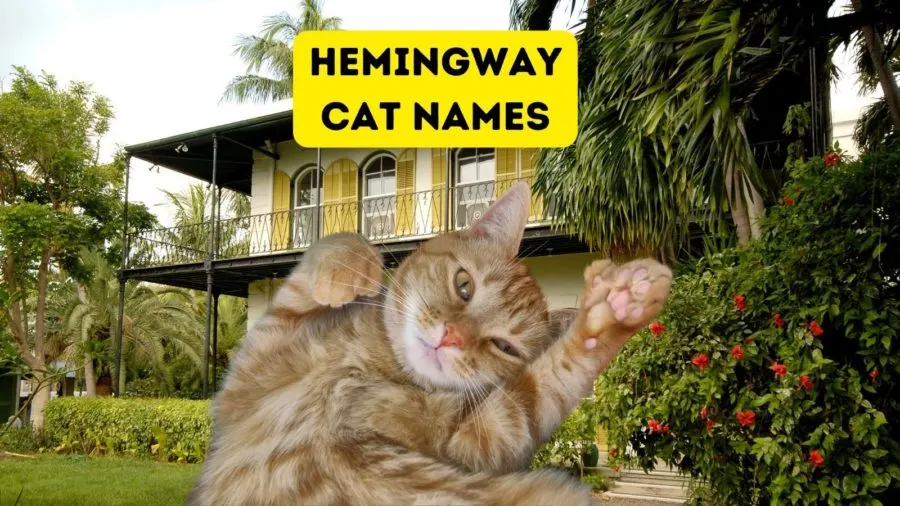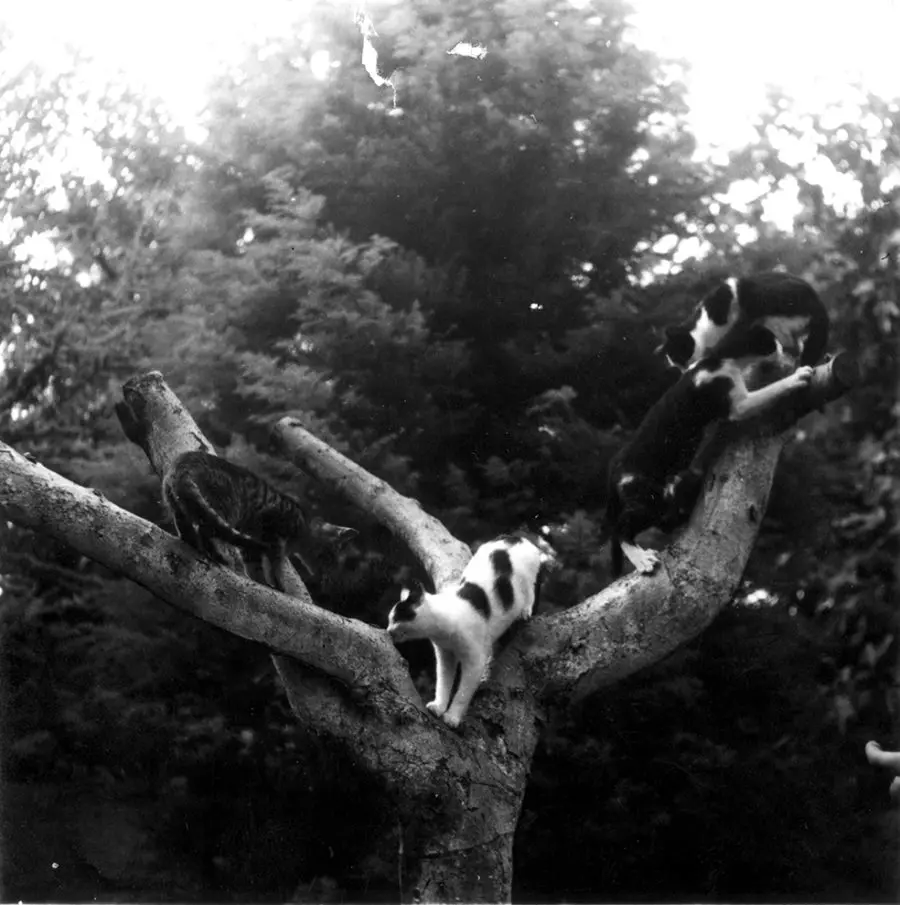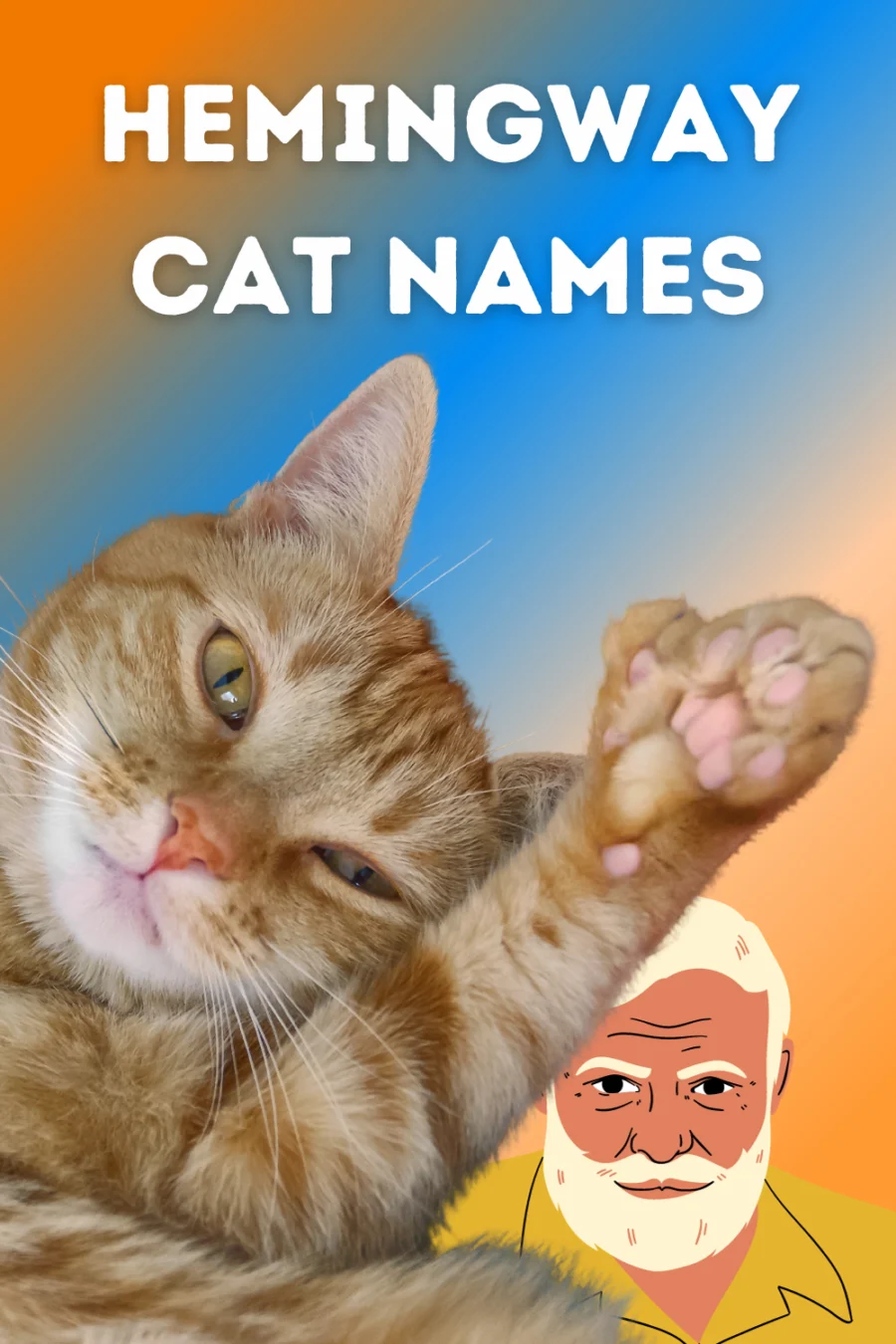Welcome to the world of polydactyl cats – those charming felines graced with extra toes, each one a unique masterpiece of nature. Often called “Hemingway cats,” after the legendary writer Ernest Hemingway who famously adored them, these cats deserve a name as special their appearance. Let’s look at names inspired by the distinctive paws of these polydactyl cats as well as names associated with Hemingway himself.
Did you know that polydactyl cats have a notable place in maritime history and folklore? Hemingway received his first polydactyl cat as a gift from a ship’s captain named Stanley Dexter. Maritime lore often held that polydactyl cats, also known as “mitten cats,” brought good luck, and they were commonly found on ships as they were believed to be superior mousers and have better balance, possibly due to their extra toes.

Today, the Ernest Hemingway Home and Museum in Key West is still home to around 40-50 cats, many of whom are descendants of Hemingway’s original cats and carry the polydactyl trait! Several years ago, we enjoyed a visit to the museum and loved seeing all the cats, who wander freely through the home and grounds.
Names for Polydactyl Cats
- Atlas: For the strength and support associated with large feet.
- Bigfoot: Named for the legendary creature known for its large footprints.
- Boots: Suggesting footwear typically worn over large feet.
- Bumble: Suggestive of a bumbling movement due to big paws.
- Clobber: A playful name that evokes the image of big, clumsy feet.
- Cushion: Indicating the soft, cushion-like quality of large paws.
- Dancer: Implying gracefulness, even with extra toes.
- Digit: Referring to the additional toes (digits) on each paw.
- Fingers: A humorous take on the extra digits.
- Flippers: Suggesting the large, flat feet of aquatic animals.
- Frosty: For cats with large, white paws resembling snow.
- Galoshes: As if the cat’s feet are as large as rain boots.
- Gloves: As if the cat’s paws are so big they could fit into gloves.
- Hobbit: After the fictional characters known for their large, hairy feet.
- Hopper: For a cat that uses its large feet for hopping or leaping.
- Jumbo: Playfully highlighting the size of the paws.
- Mittens: For the appearance of the cat’s paws resembling mittens.
- Octopaws: A play on ‘octopus,’ referencing multiple toes.
- Paddington: Suggesting large, padded feet.
- Paddles: Suggesting large feet that can paddle or swim.
- Pawsley: A cute play on the word ‘paws.’
- Peekaboo: For toes that seem to peek out.
- Plato: A philosophical nod to thinking ‘beyond the normal.’
- Sasquatch: Another reference to the mythical creature known for its large feet.
- Sneakers: Implies stealth and agility, despite large feet.
- Slippers: For soft, large feet that resemble comfy slippers.
- Snowshoes: For the wide, spreading toes that resemble snowshoes.
- Stomper: A fun name for a cat with a noticeable footfall.
- Thumbs: Indicating the extra toes that resemble thumbs.
- Tiptoe: Suggesting delicacy in movement despite the larger feet.
Hemingway’s Cats’ Names
These names, of both Hemingway’s cats and ones who have since resided at the Hemingway Home and Museum, reflect Hemingway’s diverse interests, from literature and history to pop culture, and his playful nature in naming his beloved cats.

Ernest Hemingway’s Cats, Willy and triplets Spendy, Shopsky, and Ecstacy, play in a tree at Finca Vigia, Cuba. Credit: Ernest Hemingway Photographs Collection. John F. Kennedy Presidential Library and Museum, Boston.
- Boogie Woogie: One of the cats at Hemingway’s Key West home.
- Christobal: Named after a cat at the Hemingway House.
- Dexter: Another cat from the Hemingway House in Key West.
- Dillinger: A cat named after the famous American gangster, John Dillinger.
- Duke: As in Duke Ellington, reflecting Hemingway’s appreciation of the arts.
- Ecstacy: The name of one of Hemingway’s Cuban cats.
- Emily Dickinson: Named after the famous poet.
- F. Scott Fitzgerald: A nod to Hemingway’s fellow writer and friend.
- Furhouse: A playful name reflecting the cat’s furry nature.
- Genghis Khan: Named after the famous Mongolian leader.
- Good Will: A cat from the Hemingway Home.
One cat just leads to another.
Ernest Hemingway
- Hairy Truman: A pun on the name of President Harry Truman.
- Hemingway: A cat bearing the author’s own name.
- Ivan: Named after a character in Hemingway’s writings.
- Lillian Hellman: Named after the American playwright.
- Loki: A name inspired by Norse mythology.
- Marilyn Monroe: Named after the iconic actress.
- Mark Twain: In honor of the famous American writer.
- Mouse: A playful, ironic name for a cat.
- Paris: After the city Hemingway adored and lived in.
- Picasso: Named after the renowned artist.
- Pilar: After Hemingway’s boat, the Pilar.
- Princess Six Toes: A reference to the polydactyl trait.
- Rudolph Valentino: Named after the silent film actor.
- Simba: Swahili for “lion,” suitable for a majestic cat.
- Snow White: Hemingway’s first cat, who started the six-toed lineage (some sources report that the first cat was named Snowball).
- Spencer Tracy: Named after the famous actor.
- Spendy: One of a set of triplet cats at Hemingway’s home in Cuba.
- Shopsky: Along with Ecstacy and Spendy, a triplet cat in Cuba.
- Tennessee Williams: Named after the famous playwright.
- Uncle Wolfer: A unique and playful name.
- Will Shakespeare: After the renowned playwright.
- Willy: One of the author’s cats at his home in Cuba.
- Zane Grey: Named after the author.
Punny Names
These punny names are a delightful way to acknowledge the special features of Hemingway cats or cats with extra toes, infusing a bit of humor and personality into their names.
- Purrnest Hemingway: A feline twist on Ernest Hemingway’s name.
- Pawdrey Hepburn: A play on the name of the famous actress Audrey Hepburn.
- Clawdia: A pun on the name Claudia, emphasizing the “claw” for a cat.
- Toesephine: A twist on the name Josephine, focusing on the ‘toes’ part.
- Catsanova: Combining ‘cat’ with the famous lover Casanova.
- Toe-bias: Playing on the name Tobias, emphasizing the ‘toe.’
- Digit-al Diva: A modern twist emphasizing the extra ‘digits.’
- Paw-lina: A simple pun on the name Paulina.
- Octo-paws: For a cat with many toes, like the limbs of an octopus.
- Toe-mas Edison: A witty take on the inventor Thomas Edison.
- Six-toe-speare: A literary pun on William Shakespeare.
- Hemingpaw: A straightforward play on Hemingway’s name.
- Pawsitively Purrfect: A compliment and pun rolled into one.
Names Inspired by Hemingway Literary Characters
These names, drawn from Hemingway’s rich literary landscape, offer a blend of strong, memorable characters and significant settings, perfect for naming a pet or for other creative uses.
- Adams: From various characters in “In Our Time” short stories.
- Brett: From Lady Brett Ashley in The Sun Also Rises.
- Catherine: From Catherine Barkley in A Farewell to Arms.
- David: From David Bourne in The Garden of Eden.
- Edgar: From Edgar J. Watson in Islands in the Stream.
- Francis Macomber: “The Short Happy Life of Francis Macomber”.
- Frederic: From Frederic Henry in A Farewell to Arms.
- Hadley: After Hemingway’s first wife, featured in A Moveable Feast.
- Harry Morgan: To Have and Have Not.
- Helen: From Helen Gordon in “The Snows of Kilimanjaro”.
- Jake Barnes: The Sun Also Rises.
- Jordan: From Robert Jordan in For Whom the Bell Tolls.
- Krebs: From Harold Krebs in “Soldier’s Home”.
- Manuel: From Manuel Garcia in “The Undefeated”.
- Maria: From Maria in For Whom the Bell Tolls.
- Nick: From Nick Adams in various “Nick Adams Stories”.
- Pedro: From Pedro Romero in The Sun Also Rises.
- Pilar: From Pilar in For Whom the Bell Tolls.
- Prudence: From “The Gambler, the Nun, and the Radio”.
- Rinaldi: From Lieutenant Rinaldi in A Farewell to Arms.
- Robert: From Robert Cohn in The Sun Also Rises.
- Santiago: From Santiago in The Old Man and the Sea.
- Schultz: From “The Butterfly and the Tank”.
- Scripps: From Scripps O’Neill in “The Battler”.
- Thomas: From Thomas Hudson in Islands in the Stream.
- Wilson: From “The Short Happy Life of Francis Macomber”.
- Yvette: From The Garden of Eden.
- Zelda: From “The Killers”.
Names Inspired by Locations Associated with Hemingway
These names are evocative of the places and experiences that significantly influenced Hemingway’s life and work, making them particularly meaningful and rich in history.
- Africa: Hemingway’s numerous safaris in Africa and the setting for “The Snows of Kilimanjaro.”
- Bimini: An island in the Bahamas where Hemingway frequently fished.
- Cayo: Spanish for “Key,” as in Key West, Florida.
- Cuba: Where Hemingway lived for over two decades and wrote much of his work.
- Duval: Famous street in Key West, near Hemingway’s home.
- Ebro: The river in Spain, setting for “The Old Man and the Sea.”
- Finca: After Finca Vigía, Hemingway’s home in Cuba.
- Fitzgerald: Hemingway’s contemporary and fellow author, representing the literary circle of that era.
- Gregorio: In honor of Gregorio Fuentes, who was said to be the inspiration for Santiago in The Old Man and the Sea.
- Havana: The capital city of Cuba, where Hemingway spent many years.
- Idaho: Hemingway spent his final years and is buried in Ketchum, Idaho.
- Key: Short for Key West, Hemingway’s home for many years.
- Kilimanjaro: From “The Snows of Kilimanjaro,” set in Africa.
- La Floridita: Famous bar in Havana, Cuba, frequented by Hemingway.
- Lorian: Inspired by Lorian Hemingway, Ernest Hemingway’s granddaughter.
- Marlin: Reflecting Hemingway’s passion for deep-sea fishing.
- Matador: Symbolizing Hemingway’s fascination with Spanish bullfighting.
- Maxine: Named after Maxine, a famous cat at the Hemingway Home in Key West.
- Montparnasse: Parisian district, part of Hemingway’s expatriate life in A Moveable Feast.
- Pamplona: Spanish city famous for its running of the bulls, which Hemingway frequented.
- Paris: Where Hemingway spent his early years as a writer.
- Pilar: Named after Hemingway’s boat, the Pilar.
- Ritz: After the Ritz Hotel in Paris, a frequent haunt of Hemingway.
- Sloppy Joe’s: A favorite bar of Hemingway’s in Key West.
- Spain: The setting for For Whom the Bell Tolls and a country Hemingway loved.
- Sun: From The Sun Also Rises, set in Spain.
- Truman: Named after the Truman Annex in Key West.
- Valencia: A city in Spain, part of the country that inspired much of Hemingway’s work.
- Whitehead: The street on which Hemingway’s Key West house is located.
- Wyoming: Representing Hemingway’s time spent in Wyoming.
FAQ About Polydactyl Cats
Can polydactyl cats have more than six toes?
Yes, polydactyl cats can have more than six toes. Polydactyly, the condition of having extra digits, is highly variable in its expression, which means the number of toes can differ significantly from one cat to another. While six toes per paw is common, some polydactyl cats can have seven, eight, or even more toes on one or more of their paws!
The world record for the most toes on a cat is held by a polydactyl cat with 28 toes, significantly more than the usual number. However, such high numbers are quite rare. Most polydactyl cats have just one or two extra toes per paw.
Are the extra toes functional?
The extra toes are typically fully functional, and the cats usually don’t experience any negative health effects from having these additional digits. In fact, they can sometimes appear to have an advantage in terms of grip and balance, which is particularly noticeable in kittens as they learn to climb and explore their environment.
What causes the extra toes?
Polydactyly in cats is primarily caused by a dominant genetic mutation. This means that only one parent needs to possess and pass on the gene for polydactyly for the offspring to potentially exhibit the trait. The specific gene associated with this trait in cats is often referred to as the “Hemingway gene,” named after the writer’s many polydactyl cats.
Can any cat breed develop extra toes?
Polydactyly, the condition of having extra toes, is not limited to any specific breed of cat. It can occur in various breeds and mixed-breed cats. The trait is caused by a dominant genetic mutation, meaning it can be passed down to offspring if one of the parents carries the gene responsible for polydactyly. This genetic characteristic is independent of breed.
However, polydactyly is more commonly observed in certain geographical locations, notably in the northeastern United States and Canada, and especially around port cities like Boston and Halifax. The prevalence in these areas is likely due to the historical preference of sailors for polydactyl cats, which were believed to be superior mousers and to have better balance on ships, thus making them desirable companions for long voyages.
Additionally, some cat breeds, like the Maine Coon, have shown a higher incidence of polydactyly. In the past, up to 40% of Maine Coon cats were reported to be polydactyl, although this percentage has decreased over time. This higher occurrence is more a reflection of the gene’s presence in the initial gene pool of the breed rather than an inherent breed characteristic.
In summary, polydactyly in cats is a genetic trait that can appear in any breed, but its prevalence in certain areas or breeds may be due to historical factors and breeding practices.
More Cat Names You Might Like
330+ Beach Cat Names (Including Summer, Water & Ocean Names)
260+ Purr-fecto Spanish Cat Names & Mexican Cat Names
150+ Nature Cat Names from Autumn to Zale
Pin it to remember

- 🎉 GIVEAWAY: Lord of the Pets Portrait of Your Cat! - November 26, 2024
- Review: Lord of the Pets Cat Portraits! - November 26, 2024
- Cat Adoption: FAQ You Might Have - June 28, 2024
